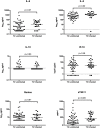T. vaginalis Infection Is Associated with Increased IL-8 and TNFr1 Levels but with the Absence of CD38 and HLADR Activation in the Cervix of ESN
- PMID: 26083468
- PMCID: PMC4470998
- DOI: 10.1371/journal.pone.0130146
T. vaginalis Infection Is Associated with Increased IL-8 and TNFr1 Levels but with the Absence of CD38 and HLADR Activation in the Cervix of ESN
Abstract
Introduction: Trichomonas vaginalis infection is associated with an increased risk of HIV infection in exposed-seronegative women (ESN) despite their unique immune quiescent profile. It is important to understand possible mechanisms, such as recruitment of activated T cells, by which T. vaginalis could facilitate HIV infection in this population.
Methods: We conducted a cross-sectional study exploring the relationships between T. vaginalis infection, inflammatory markers and T cell activation in the cervix of ESN. During scheduled study visits, participants completed a behavioral questionnaire and physical exam, including sexually transmitted infection (STI) screening and collection of endocervical sponge and cytobrush specimens. T cell and monocyte phenotypes were measured in cervical cytobrush specimens using multi-parameter flow cytometry. Cervical sponge specimens were used to measure cytokines (IL-6, IL-8,IL-10, IP-10, RANTES) using Luminex immunoassays and the immune activation marker soluble TNF receptor 1 using ELISA.
Results: Specimens of 65 women were tested. Twenty-one of these women were infected with T. vaginalis. T. vaginalis infection was associated with significantly increased concentrations of IL-8 (1275pg/ml vs. 566pg/ml, p=.02) and sTNFr1 (430 pg/ml vs. 264 pg/ml, p=.005). However, T. vaginalis infection was not associated with increased percent expression of CCR5+ T cells nor increased CD38 and HLADR activation compared to uninfected women. It was also not associated with increased expression of CCR5+ monocytes.
Conclusions: Among ESN T. vaginalis infection is associated with increased levels of genital pro-inflammatory/immune activation markers IL-8 and TNFr1, but was not associated with an increased percentage of activated endocervical T cells along the CD38 and HLADR pathways. Thus, while T.vaginalis infection may result in some reversal of the immune quiescent profile of ESN, enhanced recruitment of activated CD38 and HLADR expressing CD4+ cells into the endocervix may not be part of the mechanism by which Trichomonas infection alters HIV susceptibility in this unique subset of women.
Conflict of interest statement
Figures


References
-
- Laga M, Manoka A, Kivuvu M, Malele B, Tuliza M, Nzila N, et al. Non-ulcerative sexually transmitted diseases as risk factors for HIV-1 transmission in women: results from a cohort study. AIDS. 1993;7(1):95–102. Epub 1993/01/01. . - PubMed
-
- Schmid G, Samuelson J, Rowley J. Prevalence and incidence of selected sexually transmitted infectons, Chlamydia trachomatis, Neisseria gonorrhoeae, syphilis and Trichomonas vaginalis: methods and results used by WHO to generate 2005 estimates. World Health Organization, 2011.
Publication types
MeSH terms
Substances
Grants and funding
LinkOut - more resources
Full Text Sources
Other Literature Sources
Medical
Research Materials

